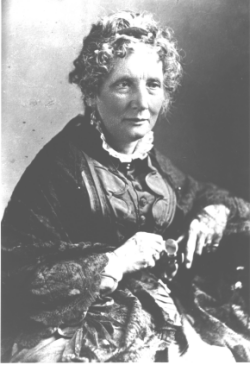
The Record - September 1998
NARA Online: Harriet Beecher Stowe, Albert Einstein, and "Rough Riders"
Documents Added to National Archives Web
The National Archives and Records Administration has added thousands of new historic documents and photographs to its web site as part of its ongoing Electronic Access Project. Among the recently digitized records are two multi-page documents from the United States Circuit Court for the Eastern District of Pennsylvania, concerning Case #9 October Session 1852, "Stowe versus Thomas;" a 96-page "Report of the Search for Amelia Earhart, July 2-18, 1937;" letters from Albert Einstein; photographs of the Three Mile Island incident; rare images from World War I; the action report on the loss of PT-109; and
the compiled Military Service Records of all the "Rough Riders."

Harriet Beecher Stowe. (NARA, 208-N-25004)
Shortly after Harriet Beecher Stowe published "Uncle Tom's Cabin" or "Life Among the Lowly," F.W. Thomas, the editor of a German newspaper in Philadelphia, began translating the work into German and publishing it in installments—without paying the requisite royalties. Mrs. Stowe and her husband sued Mr. Thomas in the Federal court in Philadelphia.
Much to the surprise and disappointment of the Stowes, the court dismissed the case, opining that Mrs. Stowe made Uncle Tom, Topsy, and other characters in the work public domain to be manipulated by other authors when she published her book. Furthermore, because the book was translated into a different language from the original, the Thomas publications were not considered to be a copy of the original, but new and independent creations. Although a remarkably interesting copyright interpretation, this case is most often used in studies of fugitive slaves. The original case files are held by the National Archives and Records Administration, Mid-Atlantic Region in Philadelphia, Pennsylvania.
The thirteen pages of handwritten Albert Einstein letters to the U.S. Navy's Bureau of Ordnance, 1943-44, refer to ordnance-related issues, such as the development of torpedoes and using mathematics in this process to maximize the impact of torpedoes against enemy targets. The letters include drawings Einstein made to illustrate his calculations.
To commemorate the 100th anniversary of the Spanish-American War, NARA has added the entire compiled military service records of the famed Rough Riders to its web site.
The War Department created these records at the turn of the century, extracting information from company muster rolls, regimental returns, descriptive books, hospital rolls, and other records, and copying it verbatim onto cards. A separate card was prepared each time an individual's name appeared on a document. Members of the National Archives Volunteer Association assisted in preparing the records and in creating the automated index to the names of the soldiers.
Roosevelt said the name "Rough Riders" was created "both by the public and by the rest of the army . . . doubtless because the bulk of the men were from the Southwestern ranch country and were skilled in the wild horsemanship of the great plains."
Recruits also came from Ivy League schools such as Harvard, Yale, and Princeton. Roosevelt also recruited at the various social clubs of Boston and New York with which he was well acquainted. From this contingent Roosevelt sought athletes such as cross-country riders and polo players. Notable among the blue-blood eastern families recruited for the Rough Riders was Hamilton Fish, the nephew of former Secretary of State Fish. Most noteworthy of the western recruits was William "Bucky" O'Neil, who was the mayor of Prescott, Arizona, and a famous sheriff. A number of Native Americans, representing tribes such as the Cherokees, Chickasaws, Choctaws, and Creeks rounded out the regiment.
Other highlights of the recently added materials include:
• "Report of the Search for Amelia Earhart, July 2-18, 1937." The report documents the search for Earhart and Fred J. Noonan by the U.S. Navy and U.S. Coast Guard shortly after the aircraft disappeared over the Pacific Ocean during an around-the-world flight.
• 29 documents from the St. George and St. Paul Pribilof Island Logbooks, 1872-1961, that include a wealth of information about the islands and their inhabitants. 105 Pribilof Islands photographs, ca. 1890-ca.1970.
• 272 photographs from photographic negatives of archaeology of the southwestern United States and of Native American delegations, 1879-1907.
• 1798 photographs of agricultural economics activities, 1911-1947, which document efficient farming and marketing techniques throughout the United States.
• 3715 photographs that document the daily life and treatment of Japanese-Americans during World War II.
• 8 documents from case file "Civil 4292, Mendez et. al. v. Westminster School District of Orange County et. al." 03/02/1945-07/18/1947. This early school desegregation case preceded Brown v. The Board of Education of Topeka, Kansas, by many years.
• 219 speeches of President Franklin D. Roosevelt, 1933-1945.
• Army, Marine Corps, and Navy military personnel files for Douglas MacArthur, John F. Kennedy, Benjamin O. Davis, Audie Murphy, and Elvis Presley;
• Prohibition court cases;
• Herbert Eugene Valentine's sketches of Civil War scenes;
• 476 additional speeches by Franklin Roosevelt and 455 additional photographs;
•100 cartoons from the Berryman Political Cartoon Collection;
• Immigration investigation files relating to the enforcement of the Chinese Exclusion Acts, 1882-1943.
The Electronic Access Project is funded by the U.S. Congress with the support of Senator Bob Kerrey of Nebraska.